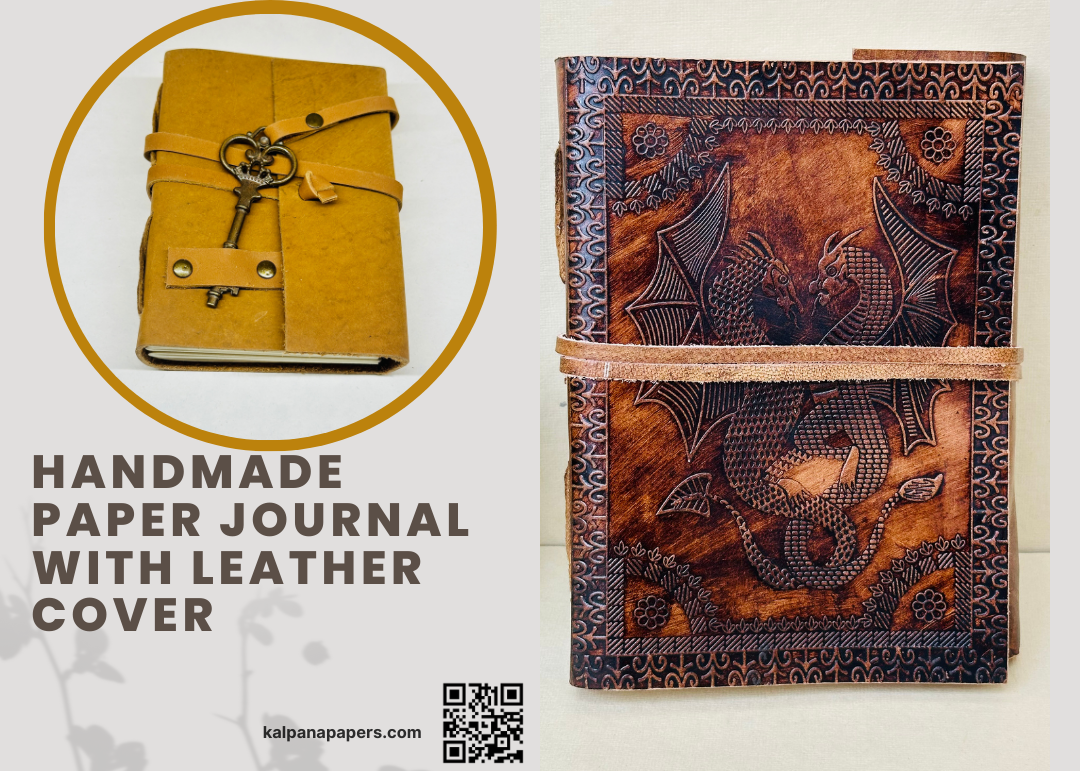Handmade Paper Journal

The Art of Journaling: Exploring Handmade Paper and Leather Journals
In the fast-paced digital age, where screens dominate our daily lives, there's an undeniable charm and authenticity in embracing traditional, tactile methods of self-expression. Handmade paper and leather journals have become more than just vessels for recording thoughts; they are works of art that reflect craftsmanship, creativity, and a connection to the past. In this exploration, we delve into the world of handmade paper and leather journals, uncovering the diverse styles, materials, and artisanal techniques that make each piece unique.
Handmade Paper Journals: A Touch of Nature:
Handmade paper journals bring an organic and rustic feel to the world of journaling. Often crafted from natural fibers like cotton, hemp, or lokta, these journals offer a sensory experience that goes beyond words on paper. The deckle edge, a rough and uneven edge created during the papermaking process, adds character and uniqueness to each page. The integration of traditional techniques, such as hand-pulping and air-drying, ensures that each sheet is a testament to the artisan's skill and dedication.
The Lokta paper journal, in particular, stands out for its sustainable sourcing. Lokta paper is made from the bark of the Daphne plant native to the Himalayas. Its eco-friendly production process and durability make Lokta paper an ideal choice for those who appreciate both environmental consciousness and quality craftsmanship.
Leather Journals: Crafting Elegance and Durability:
Leather journals, on the other hand, introduce an element of timeless elegance and durability. Crafted from various types of leather, including Italian leather, these journals provide a luxurious writing experience. The supple texture and rich aroma of genuine leather create a tactile connection between the writer and their thoughts, adding a layer of intimacy to the journaling process.
The homesure leather journal is a notable example, combining functionality with aesthetics. With its quality leather cover, stitched binding, and attention to detail, it exemplifies the marriage of traditional craftsmanship and modern design.
Combining Artistry: Moonster Leather Journals:
Moonster leather journals stand out for their commitment to combining the best of both worlds—handmade paper and genuine leather. These journals often feature refillable pages, allowing users to extend the life of their cherished journal. The moonster refillable leather journal encapsulates the essence of versatility, catering to those who seek a sustainable and customizable journaling experience.
Italian Leather Journals: A Touch of Luxury:
Italian leather journals are revered for their unparalleled quality and craftsmanship. The use of premium leather, often sourced from renowned tanneries in Italy, results in journals that are not only functional but also exude sophistication. The handmade amalfi pages, with their smooth texture and cream-colored finish, elevate the writing experience to an art form.
Recycled Paper Journals: A Commitment to Sustainability:
In an era where environmental consciousness is paramount, handmade recycled paper journals provide a solution that combines creativity with sustainability. These journals are crafted from repurposed materials, contributing to the reduction of waste and the promotion of a circular economy. The handmade recycled paper journal becomes a symbol of responsible consumerism, proving that luxury and eco-friendliness can coexist.
Versatility of Handmade Spiral Notebooks:
Handmade spiral notebooks offer a practical and functional twist to traditional journaling. The spiral binding allows for easy flipping of pages, making these notebooks ideal for quick sketches, notes, or on-the-go journaling. The combination of handmade paper and the convenience of a spiral binding makes these notebooks a versatile choice for those who prioritize both form and function.
Cultural Elegance: Handmade Sari Journals:
Infused with cultural richness, handmade sari journals incorporate recycled sari fabric into their design. Each journal becomes a canvas of vibrant colors and intricate patterns, reflecting the heritage and artistry of the regions where these saris originate. These journals are not just writing companions but cultural artifacts that celebrate diversity and tradition.
Leveraging Cotton Paper in Leather Journals:
Some leather journals, such as those with cotton paper, offer a unique combination of textures. Cotton paper, known for its softness and durability, complements the rugged elegance of leather, creating a harmonious blend of comfort and sturdiness. This pairing enhances the tactile experience and makes these journals stand out in the market.
Bulk Purchases and Wholesale Opportunities:
For businesses looking to offer these artisanal creations to a wider audience, there are opportunities to engage with handmade paper journal manufacturers and wholesalers. The ability to purchase handmade paper journals in bulk opens doors for retailers, allowing them to curate a collection that appeals to various tastes and preferences.
Best Practices in Journaling: Tips and Suggestions:
To maximize the journaling experience, users can consider factors such as the size of the journal, the type of paper, and the cover material. Large leather journals with handmade paper, for instance, provide ample space for creativity, while smaller, pocket-sized journals cater to those who prefer portability.
Conclusion:
In the realm of handmade paper and leather journals, each piece tells a unique story – a story of craftsmanship, creativity, and a connection to the past. Whether it's the rustic charm of lokta paper, the timeless elegance of Italian leather, or the cultural richness of sari journals, these artisanal creations offer more than just a blank canvas for words; they provide a medium for self-expression, reflection, and the preservation of tradition in our rapidly evolving world. As we explore the intricacies of each journal type, it becomes evident that the art of journaling extends beyond the act of writing; it is a celebration of craftsmanship, a nod to sustainability, and a homage to the timeless practice of putting pen to paper.
